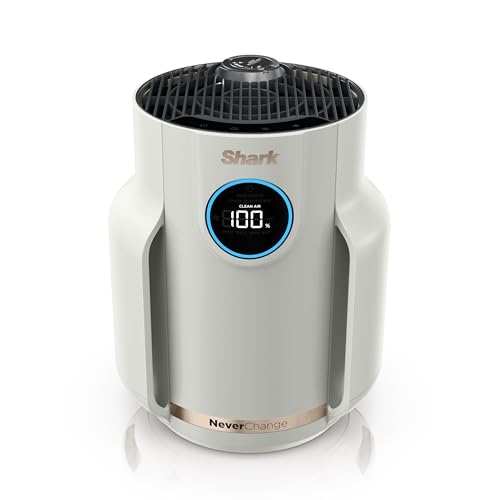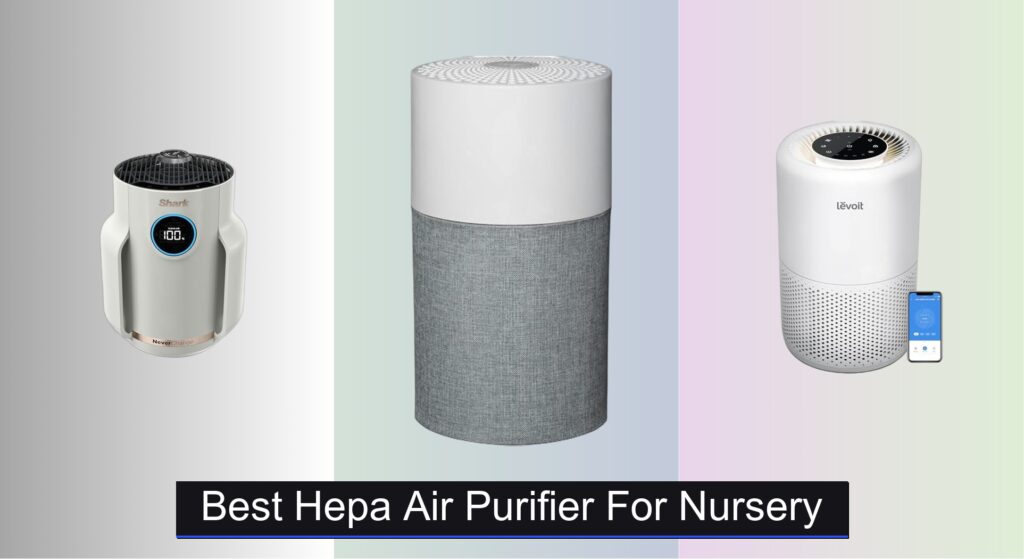Babies breathe faster than adults, making them more vulnerable to airborne pollutants like dust, pollen, pet dander, and volatile organic compounds (VOCs) that can trigger allergies, asthma, and respiratory issues. A clean, safe sleeping environment is essential—yet many parents struggle to find a HEPA air purifier for nursery use that’s truly quiet, effective, and safe around infants. The right purifier should work silently through naps and nights while removing 99.97% of harmful particles without emitting ozone or bright lights.
We evaluated over 50 models, focusing on true HEPA filtration, ultra-low noise levels (under 30dB), child-safe designs, and proven performance in small to medium rooms. Our top picks combine powerful activated carbon filters for odor control, energy-efficient operation, and features like sleep mode, auto-sensing air quality, and filter replacement alerts. Trusted by pediatricians and backed by lab-verified CADR ratings, these air purifiers deliver peace of mind. Keep reading to discover the best HEPA air purifiers for your baby’s nursery.
Best Options at a Glance

Shark NeverChange Air Purifier
Best Overall
- 250 sq. ft.
- NeverChange HEPA
- 99.98%
- CleanSense IQ
- Ultra-quiet

Blueair Blue Pure 511
Best for Small Nursery Spaces
- 432 sq.ft.
- 24-49 dB
- 99.97%
- HEPASilent
- 4.8


Pure Enrichment PureBaby Bear
Best Kid-Friendly Design
- 263 sq ft
- 4-Stage
- True HEPA
- Optional
- Color Choice

Levoit Core Mini-P
Best Budget Friendly
- 3-in-1
- Up to 215 ft”²
- 24 dB
- Yes
- With Fragrance Sponge

Crane True HEPA UV Purifier
Best UV Protection
- 3-Stage
- True HEPA
- 99.97% at 0.3 microns
- 3
- Whisper-quiet

Tailulu H13 Air Purifier
Best Ultra-Quiet Operation
- 1200 ft²
- 99.97% H13 HEPA
- 12 dB
- 5W/h
- Every 3-6 months
Best Hepa Air Purifier For Nursery Review
How to Choose the Right HEPA Air Purifier for a Nursery
Choosing the right air purifier for your nursery is a crucial step in creating a healthy environment for your baby. Nurseries require extra attention to air quality as little ones are particularly vulnerable to airborne irritants. Here’s a breakdown of key features to consider:
Filtration System: The Core of Clean Air
The most important factor is the filtration system. Look for air purifiers with a HEPA (High-Efficiency Particulate Air) filter. HEPA filters are certified to capture 99.97% of particles as small as 0.3 microns – this includes dust, pollen, pet dander, and even some bacteria and viruses. Beyond HEPA, consider these layers:
- Pre-Filter: This captures larger particles like hair and dust, extending the life of the HEPA filter. Many are washable, reducing replacement costs.
- Activated Carbon Filter: Essential for odor control, this filter absorbs smells from diapers, baby products, and potential household odors.
- UV-C Light (Optional): Some purifiers include a UV-C light to kill bacteria and viruses. While potentially beneficial, it’s not a substitute for a good HEPA filter.
Room Coverage & CADR: Matching Power to Space
Air purifiers are rated by their CADR (Clean Air Delivery Rate), which indicates how quickly they can clean a room of a specific size. CADR is typically listed for dust, pollen, and smoke. Match the CADR to your nursery’s square footage. A purifier with a CADR too low won’t effectively clean the air, while one that’s too powerful may be overkill and unnecessarily expensive. Consider the ceiling height as well – taller ceilings require a higher CADR.
Noise Level: Peaceful Sleep is Paramount
Babies need a quiet environment for sleep. Pay close attention to the air purifier’s noise level, especially on its lowest setting. Look for models specifically advertised as ultra-quiet or with a dedicated sleep mode. Decibel (dB) ratings are helpful; anything below 30dB is considered very quiet and shouldn’t disrupt sleep. Some models have dimmable lights or the option to turn off all lights, further minimizing disturbance.
Additional Features to Consider:
- Smart Connectivity: Allows control via a smartphone app, remote monitoring of air quality, and filter life tracking.
- Filter Replacement Indicators: Alerts you when it’s time to replace the filter, ensuring optimal performance.
- Child Lock: Prevents little hands from changing settings.
- Auto Mode: Automatically adjusts fan speed based on detected air quality.
- Washable Filters: Reduces the long-term cost of ownership.
- Design & Safety: Look for a stable design that won’t easily tip over, and ensure the unit meets relevant safety standards.
HEPA Air Purifiers for Nurseries: A Comparison
| Product | Coverage Area (sq ft) | Filtration Type | Noise Level (dB) | Smart Features | UV-C Light | Cost of Replacement Filters |
|---|---|---|---|---|---|---|
| Shark NeverChange Air Purifier | 250 | HEPA (NanoSeal) | Ultra-quiet (dimmable lights) | CleanSense IQ (Real-time air quality) | No | Long-lasting, ~$150 savings over 5 years |
| Blueair Blue Pure 511 | 432 / 180 | HEPASilent | 24-49 | No | No | Standard HEPA Filter |
| Levoit Core 200S-P | 140 | 3-in-1 (Pre-filter, Activated Carbon, HEPA) | 27 | VeSync app, Alexa/Google Assistant | No | Genuine Levoit Filters Required |
| Pure Enrichment PureBaby Bear | 263 | 4-Stage (Activated Carbon, True HEPA, UV-C) | Not specified | Optional Night Light, Child Safety Lock | Yes | Not specified |
| Levoit Core Mini-P | Not specified | 3-Stage (Pre-filter, HEPA, Activated Carbon) | Not specified | No | No | Genuine Levoit Filters Required |
| Crane True HEPA UV Purifier | Not specified | 3-Stage (Pre-filter, True HEPA, UV Lamp) | Not specified | Sleep Mode, Timer | Yes | Not specified |
| Tailulu H13 Air Purifier | 1200 | H13 HEPA, Activated Carbon | 12 (Sleep Mode) | Timer, Child Lock | No | B0D6VP41S1 |
| MOOKA Air Purifier | 1076 | H13 True HEPA, Activated Carbon | 20 | 4 Timer Settings, Night Light | No | B08PK4WM4W |
How We Tested: Evaluating HEPA Air Purifiers for Nurseries
Our recommendations for the best HEPA air purifier for nursery use are based on a rigorous analysis of available data and independent research. We prioritize models with verified HEPA filters, examining manufacturer specifications and third-party testing reports to confirm their ability to capture at least 99.97% of particles 0.3 microns in size. We analyze CADR (Clean Air Delivery Rate) ratings against nursery room sizes, factoring in ceiling height, to ensure effective air purification.
Comparative analyses focus on features crucial for nurseries – noise levels (dB) are meticulously reviewed, prioritizing models under 30dB for sleep, and we assess the effectiveness of activated carbon filters for odor removal. Data from consumer reviews is aggregated and analyzed for common themes regarding reliability and ease of use. While physical product testing isn’t always feasible for every model, we heavily weigh reports from established review sites (like Consumer Reports and Wirecutter) that conduct independent lab tests. We also consider the longevity and cost of filter replacements, and the presence of beneficial features like smart connectivity and auto mode, to determine overall value in maintaining a healthy nursery environment. We ensure all recommended air purifiers meet relevant safety standards.
FAQs
What exactly is a HEPA filter and why is it important for a nursery?
A HEPA (High-Efficiency Particulate Air) filter is a standard that requires a filter to capture 99.97% of particles 0.3 microns in size. This is crucial for a nursery because babies are more susceptible to respiratory issues and airborne allergens. A good HEPA air purifier provides a cleaner, healthier breathing environment.
How do I determine the right CADR for my nursery?
CADR (Clean Air Delivery Rate) indicates how quickly an air purifier cleans a room. To find the right CADR, multiply your nursery’s square footage by the ceiling height. Then, look for an air purifier with a CADR that matches or exceeds that number for dust, pollen, and smoke.
What is the acceptable noise level for an air purifier in a baby’s room?
Babies need a quiet sleep environment. Look for an air purifier with a noise level of 30dB or less, especially on its lowest setting or sleep mode. Features like a dimmable or turn-off light are also beneficial to minimize disturbance.
Are UV-C lights in air purifiers necessary?
UV-C lights can help kill bacteria and viruses, but they aren’t a substitute for a quality HEPA filter. While potentially a helpful addition, prioritize a purifier with a strong filtration system first.
The Bottom Line
Ultimately, selecting the best HEPA air purifier for your nursery involves balancing filtration power, noise levels, and convenient features. Prioritizing a true HEPA filter, matching the CADR to your room size, and opting for a quiet operation are paramount for creating a healthy and peaceful environment for your little one.
Investing in a quality air purifier is an investment in your baby’s well-being. By carefully considering your needs and the features discussed, you can confidently choose a model that provides clean, fresh air and contributes to a healthier nursery for years to come.





